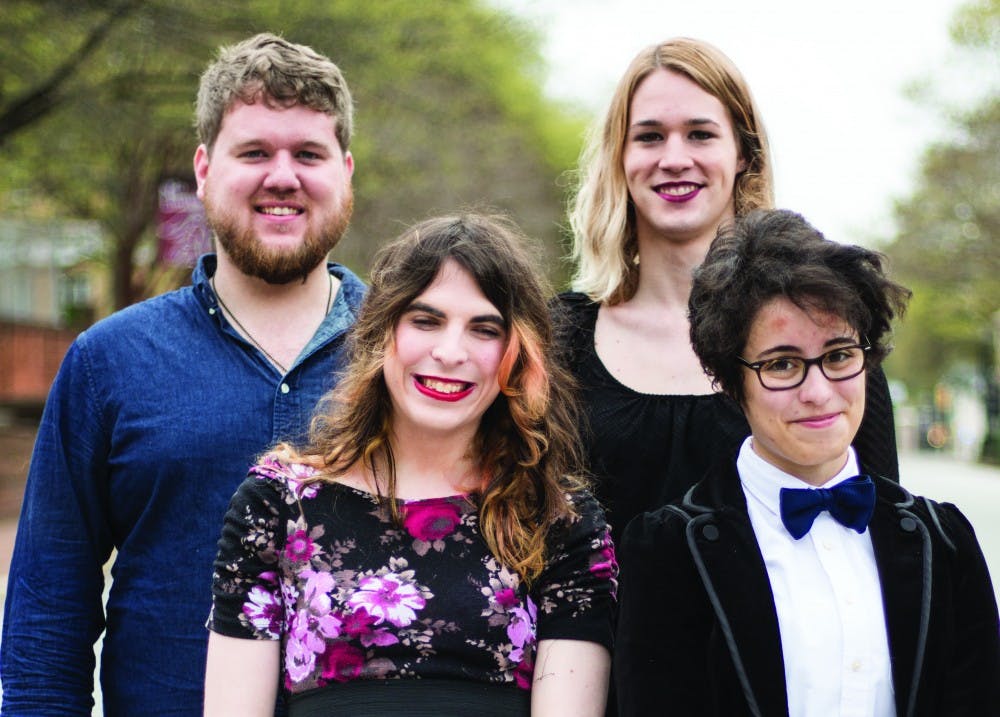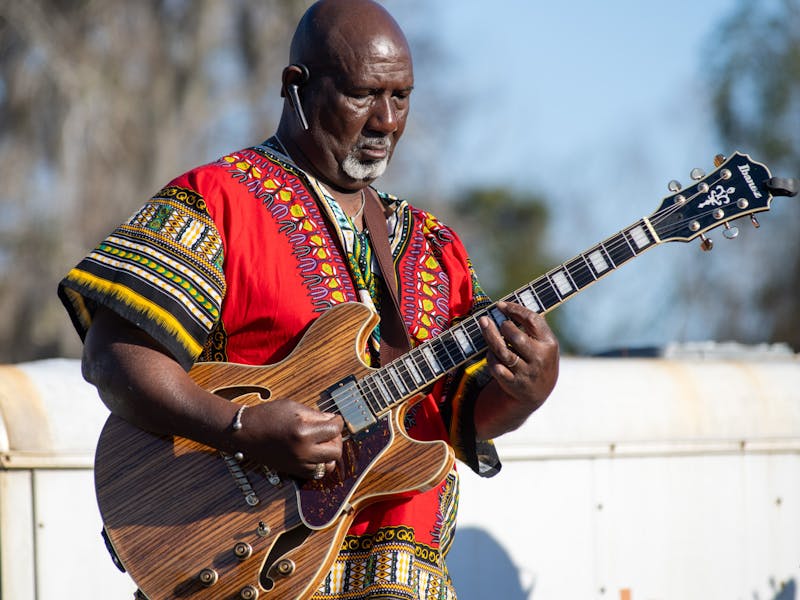Slapping the “snooze” button on her alarm, USC sophomore Rukia Brooks begs the machine for 10 more minutes of precious slumber. Like so many of her peers, she reluctantly climbs out of her warm nest of blankets and begins her morning routine.
Across campus in Maxcy, freshman Bailey Enlow is responding to a loving morning text from her girlfriend. It’s their 5-year anniversary, and she’s calling to confirm their reservations at Saluda’s.
Meanwhile, junior Thomas Jones* is headed to Russell House for breakfast to study before his big chemistry exam. Sitting down at a booth, he opens his laptop and begins to religiously recite his notes, hoping that some of it sticks.
Brooks, Enlow and Jones are all doing quite average, everyday college things. However, they are each extraordinary— and not because they got out of bed to study. They are all transgender. Transgender is one of those words we hear in passing, on Facebook or in one of our sociology classes. It’s a word we often lose in our memories or misunderstand. Oftentimes, we hear it referred to as “a boy trapped in a girl’s body” or some other problematic definition, but transgender identities are much more complex and diverse.
People tend to get confused about the distinctions between sexuality, sex and gender. Sexuality is defined as one’s orientation in terms of their feelings, desires, and attractions. Sex is largely understood as the biological characteristics used to label people – chromosomes, hormones and anatomy.
Sex, like sexuality and gender, is a spectrum. Many bodies do not fit the binary that society has constructed. Some people are categorized as intersex due to biological characteristics that don’t fit the norm. Furthermore, hormones, anatomy and legal sex are modifiable, though still independent from gender.
There is nothing inherently male or female about human body parts. That’s usually a new idea for many people. We so often hear “boy parts” and “girl parts.” But if a woman has a penis, is that penis still “boy parts?” Trans activist Sophia Banks (@sophiaphotos) tweeted in January, “I am cool being a woman with a dick. Waiting for society to catch up.” As a culture, we have taken away the right for people to have others refer to them and their bodies as they see fit. If someone tells us that they identify as a woman, then her face is a woman’s face, her leg a woman’s leg and her clothing is a woman’s clothing.
For most people, gender identity is in accord with the sex they were assigned at birth; these individuals are known as cisgender. For transgender people, however, gender identity may differ from assigned sex or corresponding social roles. Because gender identity is internal, others cannot assume it, regardless of the individual’s gender expression. Got all that?
Now, let’s talk media. Some well-meaning USC student may ask, “Well, surely the people reporting transgender topics know a lot about them…right?” Unfortunately, it’s usually the opposite. All too often, transgender individuals are misgendered (meaning that people don’t use the correct pronouns or names when referring to a trans individual). Misgendering is dangerous. It means that people disregard the identity and the lived experiences of the transgender person. We often put them in boxes that make their lives more palatable to us. “Orange is the New Black” actress, trans woman of color and trailblazing goddess Laverne Cox even called misgendering “an act of violence.” That’s a bold statement. They’re just words; does it really matter that much?
Yes, it does. Nine trans women were murdered in the United States between January 1 and March 16. If we include trans people who have committed suicide, the number jumps to at least 14 that we know of. The vast majority of these are women of color.
According to “Injustice at Every Turn: A Report on the National Transgender Discrimination Survey” (2011), transgender and gender non-conforming people face a 41 percent rate of attempted suicide (compared to 1.6 percent in the general population); double the rate of unemployment; a 78 percent harassment rate in K-12 schools; 63 percent rate of a severe, life-altering instance of discrimination; 19 percent rate of complete medical care denial; and a largely increased rate of harassment, poverty, rape and murder. Words—which, yes, seem harmless at first—often lead to these acts of violence.
And these aren’t just statistics. This is Leehlah Alcorn, a 17-year-old trans girl who threw herself in front of a car because her family wouldn’t accept her. (They instead opted to send her to a type of therapy condemned by psychiatric groups nationwide.) This is Taja DeJesus, a 36-year-old trans woman of color who was found stabbed to death in a San Francisco stairwell. This is Bri Golec, a 22-year-old trans girl who was murdered by her father for attending a transgender support group. Ending violence against the transgender community begins with respect and education.
But what about our campus? We do have resources for transgender and gender non-conforming students at USC. Kayla Lisenby is the coordinator for Lesbian, Gay, Bisexual and Transgender (LGBT) Programs in the Office of Multicultural Student Affairs.
“We are working to grow the resources that are available to our trans and gender non-conforming students,” Lisenby says. “Much of our work is derived from best practices in the field and the work of our Trans Task Force, a group of faculty and staff who meet regularly to work to improve the campus culture for our trans students.”
In regards to the ever-changing cultural climate on campus, she assures us that USC has “…a strategic plan for increasing the inclusivity of our campus for trans and gender non-conforming students over the next several years.”
Our student body offers resources as well. New to USC is the Trans Student Alliance, which serves as an almost peer-led Trans Task Force. Still in its infancy, the organization is a safe space for all trans-identifying students to come together and turn discussion into action. The group is planning on launching a Facebook page very soon.
The largest student organization that meets weekly is the Bisexual, Gay, Lesbian, Straight Alliance (BGLSA). This group, headed by junior Devon Sherrell, offers a wide range of meeting topics and programming throughout the year. Sherrell tells us, “As an inclusive LGBTQ+ organization, BGLSA provides a social, service and advocacy network for the entire community, including trans and gender non-conforming students, faculty and staff. BGLSA will provide the committee with the resources they need to foster active dialogue and solutions for some of the problems trans and gender non-conforming students face on campus.”
As for the challenges that we’ve faced in past years with getting trans-inclusive policies and programming to Carolina, Sherrell says, “Unfortunately, USC has had instances of violence against students within the trans and gender non-conforming community. We also have had many pitfalls and roadblocks in pushing gender-inclusive housing, and only this year has the university finally included gender in its non-discrimination clause.”
Even still, Enlow admits she found solace in coming to college. “I’ve always known [I was transgender],” she says. “But I didn’t know the word for it until I was around 15 or 16 and even then I was like, ‘No, this wouldn’t be good.’ My parents were really Christian and they wouldn’t have been happy, and it would have made life harder for me at home. I waited until the summer before I came to USC to really come out as trans.” Enlow says that she found a support group in BGLSA and has had a generally positive experience in residence halls, which can sometimes be challenging for transgender college students. Even better? Her girlfriend is her biggest supporter!
Brooks also talked to us about coming out. “[It] was a difficult process,” she says. “I have had trash thrown at me, been verbally harassed and threatened, but these are very minor compared to the overwhelming love and support I have gotten from friends.”
Brooks gives credit to progressive student organizations such as the Feminist Collective and the Secular Student Alliance for helping her feel more comfortable with herself and coming out at USC. “I, along with many others… hope to continue to better South Carolina through our efforts to make sure everyone finds a home here at USC.”
Jones speaks of the prevalence of his community. “Trans people are everywhere,” he says. “We’re at USC; we’re your neighbors. We went to your high school. We’re your classmates and your students. If you haven’t met a trans person, you will. And chances are you have met a trans person, but you didn’t know it – we don’t always look like you would expect us to look.”
Jones is proud of his identity and has a message for students on this campus. “[Transgender] lives are complex and interesting, challenging and beautiful. Our lives are also normal and less tragic than the media would have you believe. Most importantly, being transgender is a healthy variation of human existence… I love being transgender.”
*Name has been changed to protect the identity of the student.
Both writers of this piece openly identify within the transgender spectrum.



